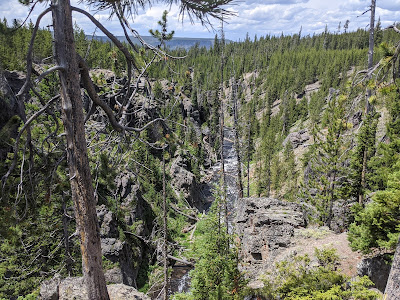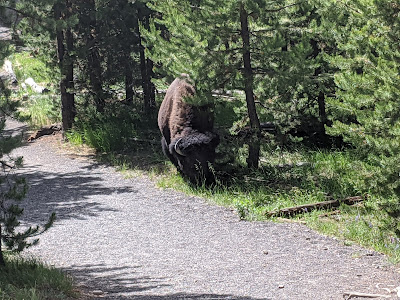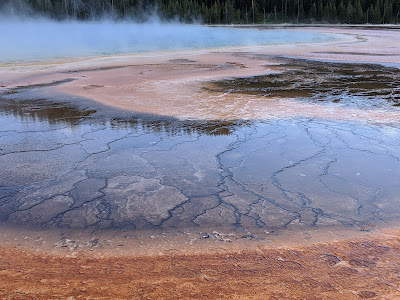After spending the morning exploring Yellowstone National Park's jaw-dropping Old Faithful and Grand Geyser in the Upper Geyser Basin, Steven and I were hungry. We hoped to find a picnic spot further south but were both surprised and disappointed not to find any signs for them at all in the park. We ended up having to drive back north in the direction of Old Faithful again to hike at Black Sand Basin.
Just south of Old Faithful was Keppler's Cascades. As we always loved seeing falls on our adventures, we stopped to see these.
A little further on was Black Sand Basin. Its name derived from the black obsidian or volcanic glass. Oranges, greens, and other colors in and around the hot springs came from thermophiles or heat-loving micro-organisms.
It must have been because we were there on one of the busiest holiday weekends of the year but trying to find parking spots was crazy in the park! We couldn't imagine the park being any more crowded than it was that day, especially since we were there in the age of Covid when presumably not so many people had ventured far from home. I spoke to a ranger who said the park was 89 percent full but they were no longer allowing any tour buses in the park. We were thankful for that!
In the top left, notice the spill off from a geyser flowing into the river.
Though not as large as the Upper Geyser Basin we'd just seen, Black Sand Basin was still a good size.
Emerald Pool:
At first glance, geyser basins may appear to be stark and lifeless places. Amazingly, though, they teemed with both microscopic and visible life year-round. Isn't it amazing that the hottest thermal features contained tiny microbes that lived in one of the earth's most extreme environments?
We learned that it's only been recently discovered that runoff channels from geysers and hot springs also sustained a variety of life. Thermal features also played an important role in the winter survival of Yellowstone's larger animals like buffalo and elk. The warmer ground temperatures melt the snow, making foraging for grasses and other vegetation much easier.
The drop-dead gorgeous Rainbow Pool:
We lucked out again arriving at the perfect time to see Cliff Geyser erupt.
I don't know about you if you read the last post and the beginning of this one but Steven and I still hadn't our fill of geysers that day. That's why we were more than happy to see Spouter Geyser spout off in two different areas.
The trees at the otherworldly-looking Opalescent Pool were imaginatively described as having 'bobbysox trunks' because they were saturated with silica!
From Black Basin, we made our way two miles further north to Biscuit Basin which was described as particularly volatile. Back in August of 1959, an earthquake recorded at 7.5 on the Richter Scale had its epicenter near Biscuit Basin.

Black Opal Spring:
How I loved the textures, interesting shapes, and their colors!
Four days after the earthquake in 1959, Sapphire Pool began to erupt violently, blowing away large 'rock biscuits' around the crater. The biscuit-shaped mineral formations gave the basin its name.
Even though there was nothing visible here at Shell Spring, we could hear lots of bubbling and gurgling under the ground! It was a good reminder that appearances weren't everything.
Our plan was to hike next to nearby Mystic Falls.
However, a buffalo in the middle of the trail forced us to reconsider our plans! We waited a good while, hoping it might reenter the forest but it just stayed put, not moving except swishing its tail nonstop.
We noticed twenty people coming across the buffalo from the opposite direction having finished their falls hike. They ended up choosing to forge a path through the forest away from the buffalo to return to the main trail but Steven and I didn't want to take chances like that. Plus, who knew where the buffalo might decide to go next and he could move far faster than we could?!
Never had we had such a good excuse to forego hiking!
Instead, we drove a few miles north to Midway Geyser Basin, primarily so we could view its Grand Prismatic Spring, the national park's largest hot spring. It had to be one of the park's most popular spots as it took us just shy of 30 minutes to turn in and find a parking spot!
The channel runoffs into the Firestone River was what drew me to this scene.
We came first to Excelsior Geyser where it was reported in 1880 the geyser erupted in bursts that ranged from 50-300 feet high. That 'thermal violence' formed the jagged crater and also ruptured the geyser's underground system which has prevented any more geysers since 1890.
Needless to say, Steven and I would have given our eyeteeth to be here on September 14th, 1985, when the geyser erupted with major eruptions for 47 hours straight. Wouldn't you also want to be here whenever this powerful geyser erupts again?!
Though the eruptions at Excelsior have been erratic, there were still more than 400 gallons of boiling water per minute being pumped out over the rim of the crater into the Firehole River. That was equivalent to nine Olympic-sized pools!
Layers of sinter, i.e. the preserved remains of ancient microbial communities, formed the geyser wall.
After a short walk along the boardwalk, we arrived at the basin's signature feature, the Grand Prismatic Spring, the third-largest in the world, and the largest and most brilliant of Yellowstone's many colorful springs. The spring's blue color in the middle was due to sunlight being scattered by fine particles suspended in the water.
Grand Prismatic's massive expanse stretched about 200 feet across. We were so lucky that day to have such unobstructed views of the spring because people often find it cloaked in steam because of the water's high temperature. The hot spring poured almost 500 gallons of hot water each minute into the Firehole River.
For anyone interested in photography, the spring and its graceful terraces were sublime and unbelievably spectacular! Thank goodness, we hadn't been 'allowed' by the buffalo to go on the hike to the falls or we may have omitted stopping here.
We then hopped back in the car to drive a few more miles north to Lower Geyser Basin along the circular Firehole Lake Drive. Our first stop was at Firehole Spring, which has more or less perpetual spouting caused by a combination of superheated boiling water, rising steam, and gas bubbles.
The most popular feature on the drive was the Great Fountain Geyser as it was also one of the park's major geysers. As you may remember if you read my previous post, earlier that day, we'd had uncanny timing arriving at both Old Faithful and Grand Geysers within minutes of their eruptions rather than having to wait literally hours. On arrival at Great Fountain at 4:30, a sign let us know that the next eruption 'might' be anytime from 4:33-5:30 even though intervals typically ranged from 8 to 15 hours! I was thrilled that we had 'timed' our arrival here so perfectly; Steven was a little less ecstatic, mind you, as I think he was understandably getting 'geysered out' by then!
Seeing the spurts of water get higher and higher made us think the spectacle of the large eruption was just moments away. However, Mother Nature had other ideas and there was 'just' more of the same for what seemed an interminable time.
At this point, Steven wanted to 'give' the geyser two minutes longer to erupt or else we'd leave but I persuaded him to just hang around a bit longer. Fortunately, my powers of persuasion and Steven's patience won out as it finally erupted, if not exactly into a 'great' fountain, at least lots of bubbling and steam.
Steven had finally had quite enough of waiting for the 'big show' and said we had to leave as we still had a long drive ahead of us to the park's northern entrance and our hotel in Gardiner, located just one minute outside the park. Of course, just as we slowly drove toward the park's next feature I looked back and noticed Great Fountain was erupting after all. I urged Steven to stop as I wanted to get some last photos in of a geyser erupting in the park!
When Great Geyser did finally blow, it was so high, it totally blocked our view of the sun. I loved it when I even got 'showered' on by the spray of water as I stood, all agog, watching on the side of the road while Steven waited in the car!
I was so, so glad we hadn't missed the eruption as we came so close to doing so.
Just a hundred or so yards down the drive was the many-century-old White Dome Geyser, one of the largest cone geysers in Yellowstone whose size had increased with each eruption. In cone geysers, the narrow jet of water erupts through a slim vent compared to fountain geysers like Great Fountain that erupts through a large vent with a wide opening.
It seemed everyone we spoke to while waiting at Great Fountain Geyser had installed the park's app on their phones but we never knew of it or thought to look into it! That was why it was so surprising that geyser after geyser, we just lucked out and had ended up being in the right place at the right time all day long. I hope you will have the same great fortune if you get to visit Yellowstone's glorious geysers one day.
Next post: No more geysers at Yellowstone but the still stunning Mammoth Hot Springs!
Posted on November 28th, 2020, from another cloud-free, coatless day in late November in the Denver suburbs. As ever, I hope you and your loved ones are safe and connected in these challenging times that sees no letup.





































































You should see the park in the winter. Its cold and magical and very few people. Lil Red
ReplyDeleteWe'd sure love to one day, Janina. I can imagine it must be magical in an altogether different way.
ReplyDeleteHi Annie, thank you for this edition of Annie's National Geographic! Lots of beauty I hadn't known about. I almost got there once upon a time but Elena and I weren't having a good day so we passed!
ReplyDelete"Geysered out" is one of those phrases you don't hear very often but I can see how much you were enjoying them. I would have enjoyed it!
Andrew,
DeleteI love your description of the post as Annie's National Geographic - too cute! Too bad you and Elena missed out on seeing the majesty of Yellowstone for yourselves.
Love you,
Annie
Lovely, my dear. How fortunate to have run into a buffalo in the wild. It's not a very common experience, at least here in Ontario. Take care.
ReplyDeleteI SHOULD hope that running into a buffalo in the wild in Ontario would be rare!
DeleteLove to you and Gloria,
Annie